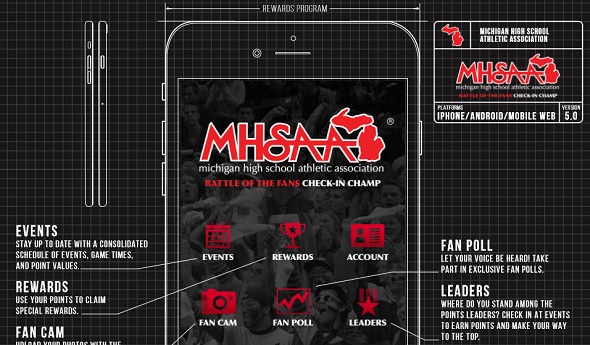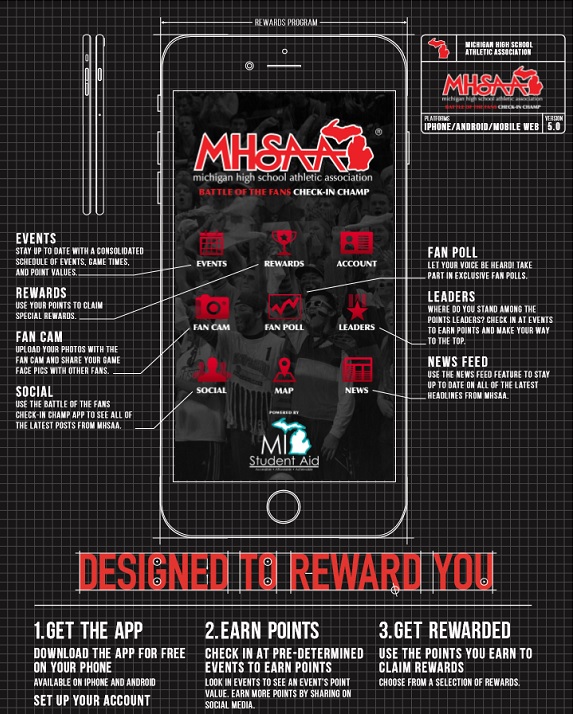
'Check-in Champ' App Rewards Fans
January 10, 2017
By Geoff Kimmerly
Second Half editor
The Michigan High School Athletic Association and SuperFanHigh, a leading fan loyalty and engagement company, have launched a mobile app that will allow students, faculty, alumni, community members and all fans to earn prizes and college scholarships by showing support for high school basketball teams.
To participate, fans simply need to download the “Check-in Champ” app for free from the Apple iTunes or Google Play online stores and then check in at high school girls and boys basketball games they are attending this season. SuperFanHigh will track these check-ins and provide standings of fans who attend the most events statewide beginning Tuesday, Jan. 10. Fans “checking in” accrue points toward prizes including a total of $5,000 in college scholarships sponsored by MI Student Aid.
“The ‘Check-in Champ’ contest provides an exciting opportunity for our schools to promote their regular-season girls and boys basketball games,” MHSAA Executive Director John E. “Jack” Roberts said. “We’re eager to see how this will build more excitement at games, both during the regular season and the MHSAA tournament, and we’re appreciative of MI Student Aid for adding significant incentive for students and their families who support their classmates and communities.”
For the remainder of this Michigan high school boys and girls basketball season, fans who attend games will earn points. When registering on the app, fans must select their favorite school. Schools will be divided by Class: A, B, C and D. A $3,000 scholarship will be awarded to the fan who earns the most points overall across all four classes, and $500 scholarships will be awarded to fans who earn the most points in each class.
Only student fans will be eligible to use the college scholarships; however, fans who are not students may still compete for the scholarships and designate them for specific students should they win the contest. All fans, including those who are not students, will be able to earn app “badges” as they accrue points, and the top 100 point-getters will receive shirts printed to celebrate their accomplishment in the contest.
“We are excited about partnering with the MHSAA to launch this new app,” said Anne Wohlfert, Director of the Student Financial Services Bureau at the Michigan Department of Treasury. “We are pleased to offer $5,000 in scholarship dollars to the students who attend the most games. This joint venture aligns with our goals to provide high school students and their families with student financial resources and information.”
The app provides other information for students and fans including their selected schools’ boys and girls basketball team schedules, MHSAA news and an opportunity to share photos through a ‘fan cam.’ Participants may accrue bonus points by answering MHSAA basketball trivia questions and promoting their “check-ins” on social media.
SuperFanHigh is a division of its parent company, SuperFanU and provides fan experiences for more than 300 high schools and colleges/universities across the country. The company is leading the market in developing innovative platforms that allow the communication and marketing between students/fans and schools to be more engaging and efficient.
“We know that our partnership with MHSAA will yield lots of excitement this year across the state of Michigan,” says Kayla Mount, co-founder and COO of SuperFanU.


MHSAA Ups Awareness with 'Heat Ways'
August 6, 2013
With the beginning of a new year for high school sports just a week away, members of the Michigan High School Athletic Association have been preparing to follow a new model policy for hot weather activity, guided by a new publication and a rules meeting emphasis on heat and hydration.
The MHSAA Representative Council adopted a Model Policy for Managing Heat & Humidity earlier this year, a plan many schools have since adopted at the local level. The plan directs schools to begin monitoring the heat index at the activity site once the air temperature reaches 80 degrees, and provides recommendations when the heat index reaches certain points, including ceasing activities when it rises above 104 degrees.
The model policy is outlined in a number of places, including a new publication called Heat Ways, which is available for download from the MHSAA Website. Heat Ways not only provides the model policy, but addresses the need for proper acclimatization in hot weather.
The topic of heat-related injuries receives a lot of attention at this time of year, especially when deaths at the professional, collegiate and interscholastic levels of sport occur, and especially since they are preventable in most cases with the proper precautions. In football, data from the National Federation of State High School Associations shows that 41 high school players have died from heat stroke between 1995 and 2012.
Even before the days of the Internet, the MHSAA held a leadership role in providing resources each Spring to assist schools in their preparation for hot preseason practices. In addition to the information now contained in Heat Ways, the Association is making dealing with heat, hydration and acclimatization the topic for its required preseason rules meetings for coaches and officials. The 15-minute online presentation spends a fair amount of time talking about the need for good hydration in sports, regardless of the activity or time of year.
The Health & Safety Resources page of the MHSAA Website has a set a number of links to different publications and information, and a free online presentation from the National Federation of State High School Associations. Visit MHSAA.com, click on Schools, and then on Health & Safety Resources to find the information.
“We know now more than we ever have about when the risk is high and who is most at risk, and we’re fortunate to be able to communicate that information better than ever before to administrators, coaches, athletes and parents," said John E. “Jack” Roberts, executive director of the MHSAA. “Heat stroke is almost always preventable, and we encourage everyone to avail themselves of the information on our website.”
Roberts added that the first days of formal practices in hot weather should be more for heat acclimatization than the conditioning of athletes, and that practices in such conditions need planning to become longer and more strenuous over a gradual progression of time.
“Then, schools need to be vigilant about providing water during practices, making sure that youngsters are partaking of water and educating their teams about the need for good hydration practices away from the practice and competition fields,” Roberts said.

